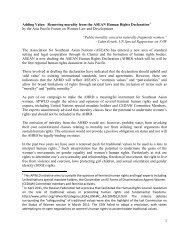A Digest of Case Law on the Human Rights of Women - Asia Pacific ...
A Digest of Case Law on the Human Rights of Women - Asia Pacific ...
A Digest of Case Law on the Human Rights of Women - Asia Pacific ...
You also want an ePaper? Increase the reach of your titles
YUMPU automatically turns print PDFs into web optimized ePapers that Google loves.
Apparel Export Promoti<strong>on</strong> Council v A. K. Chopra (India)<br />
warranted was unrealistic and gave <strong>the</strong> High Court a lack <str<strong>on</strong>g>of</str<strong>on</strong>g> credibility. In cases<br />
involving sexual harassment, courts are required to examine <strong>the</strong> broader circumstances<br />
<str<strong>on</strong>g>of</str<strong>on</strong>g> <strong>the</strong> case and not to focus <strong>on</strong> narrow technicalities such as <strong>the</strong> dicti<strong>on</strong>ary meaning<br />
<str<strong>on</strong>g>of</str<strong>on</strong>g> <strong>the</strong> expressi<strong>on</strong> “molestati<strong>on</strong>”. They must look at <strong>the</strong> entire material to evaluate <strong>the</strong><br />
genuineness <str<strong>on</strong>g>of</str<strong>on</strong>g> <strong>the</strong> complaint using sensitivity and sympathy. The Court held that <strong>the</strong><br />
High Court had ignored <strong>the</strong> fact that <strong>the</strong> c<strong>on</strong>duct <str<strong>on</strong>g>of</str<strong>on</strong>g> <strong>the</strong> resp<strong>on</strong>dent was c<strong>on</strong>trary to<br />
moral sancti<strong>on</strong>s, decency and was <str<strong>on</strong>g>of</str<strong>on</strong>g>fensive to <strong>the</strong> employee’s modesty. Fur<strong>the</strong>r, a<br />
reducti<strong>on</strong> <str<strong>on</strong>g>of</str<strong>on</strong>g> punishment in cases <str<strong>on</strong>g>of</str<strong>on</strong>g> sexual harassment, <strong>the</strong> Court stated, may have a<br />
demoralising effect <strong>on</strong> female employees and would be a retrograde step. Finally, it<br />
found <strong>the</strong>re was no justificati<strong>on</strong> in this case for <strong>the</strong> High Court to interfere with <strong>the</strong><br />
punishment imposed by <strong>the</strong> Departmental Authority.<br />
In its decisi<strong>on</strong>, <strong>the</strong> Court relied up<strong>on</strong> Vishaka v State <str<strong>on</strong>g>of</str<strong>on</strong>g> Rajasthan (1997 VII AD S.C.<br />
53) where <strong>the</strong> Supreme Court held that <strong>the</strong> C<strong>on</strong>stituti<strong>on</strong> <str<strong>on</strong>g>of</str<strong>on</strong>g> India 1949 protected <strong>the</strong><br />
rights <str<strong>on</strong>g>of</str<strong>on</strong>g> women to a safe working envir<strong>on</strong>ment free from sexual harassment and abuse.<br />
The Court also referred to a number <str<strong>on</strong>g>of</str<strong>on</strong>g> internati<strong>on</strong>al c<strong>on</strong>venti<strong>on</strong>s and norms in support<br />
<str<strong>on</strong>g>of</str<strong>on</strong>g> its interpretati<strong>on</strong> <str<strong>on</strong>g>of</str<strong>on</strong>g> <strong>the</strong> facts. It noted that <strong>the</strong> Internati<strong>on</strong>al Labour Organisati<strong>on</strong><br />
seminar held in Manila in 1993 recognised that sexual harassment in <strong>the</strong> workplace<br />
was a form <str<strong>on</strong>g>of</str<strong>on</strong>g> gender discriminati<strong>on</strong> against women. CEDAW and <strong>the</strong> Beijing<br />
Declarati<strong>on</strong> direct all state parties to take appropriate measures to prevent all forms<br />
<str<strong>on</strong>g>of</str<strong>on</strong>g> discriminati<strong>on</strong> against women. Article 7 <str<strong>on</strong>g>of</str<strong>on</strong>g> <strong>the</strong> Internati<strong>on</strong>al Covenant <strong>on</strong> Social<br />
Ec<strong>on</strong>omic and Cultural <strong>Rights</strong> 1966 recognises <strong>the</strong> right <str<strong>on</strong>g>of</str<strong>on</strong>g> women to fair c<strong>on</strong>diti<strong>on</strong>s<br />
<str<strong>on</strong>g>of</str<strong>on</strong>g> work. The message <str<strong>on</strong>g>of</str<strong>on</strong>g> <strong>the</strong>se instruments, <strong>the</strong> Court held, is applicable to both <strong>the</strong><br />
Indian State to make <strong>the</strong>ir laws sensitive to gender, and to <strong>the</strong> courts to give <strong>the</strong>m effect<br />
wherever possible.<br />
Commentary<br />
The Court broadened <strong>the</strong> meaning <str<strong>on</strong>g>of</str<strong>on</strong>g> sexual harassment from physical molestati<strong>on</strong> to<br />
include circumstances such as requests for sexual favours and o<strong>the</strong>r direct or implicit<br />
verbal and physical c<strong>on</strong>duct with sexual overt<strong>on</strong>es. It noted that it is discriminati<strong>on</strong><br />
when <strong>the</strong> submissi<strong>on</strong> to, or rejecti<strong>on</strong> <str<strong>on</strong>g>of</str<strong>on</strong>g>, such c<strong>on</strong>duct by a female employee could affect<br />
her employment and unreas<strong>on</strong>ably interfere with her work performance by creating<br />
an intimidating or hostile work envir<strong>on</strong>ment. The Court also referred to internati<strong>on</strong>al<br />
c<strong>on</strong>venti<strong>on</strong>s and norms that protect <strong>the</strong> rights <str<strong>on</strong>g>of</str<strong>on</strong>g> women such as CEDAW and noted<br />
that courts should interpret domestic legal instruments in line with <strong>the</strong>ir provisi<strong>on</strong>s,<br />
reinforcing judicial willingness to adopt internati<strong>on</strong>al principles <str<strong>on</strong>g>of</str<strong>on</strong>g> equality. It observed<br />
that <strong>the</strong> fundamental rights guaranteed in <strong>the</strong> C<strong>on</strong>stituti<strong>on</strong> were <str<strong>on</strong>g>of</str<strong>on</strong>g> sufficient amplitude to<br />
encompass all facets <str<strong>on</strong>g>of</str<strong>on</strong>g> gender equality, including <strong>the</strong> preventi<strong>on</strong> <str<strong>on</strong>g>of</str<strong>on</strong>g> sexual harassment<br />
and abuse. Fur<strong>the</strong>r, it noted that each incident <str<strong>on</strong>g>of</str<strong>on</strong>g> sexual harassment in <strong>the</strong> workplace<br />
resulted in a violati<strong>on</strong> <str<strong>on</strong>g>of</str<strong>on</strong>g> <strong>the</strong> fundamental right to gender equality and <strong>the</strong> right to life<br />
and liberty, <strong>the</strong> two most precious rights guaranteed by <strong>the</strong> C<strong>on</strong>stituti<strong>on</strong>. Such findings<br />
are undoubtedly beneficial to <strong>the</strong> recogniti<strong>on</strong> <str<strong>on</strong>g>of</str<strong>on</strong>g> <strong>the</strong> rights <str<strong>on</strong>g>of</str<strong>on</strong>g> women.<br />
46



